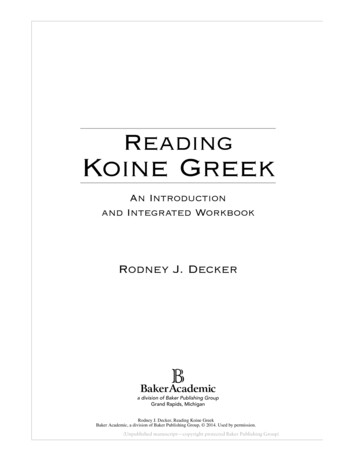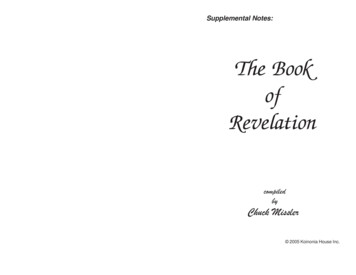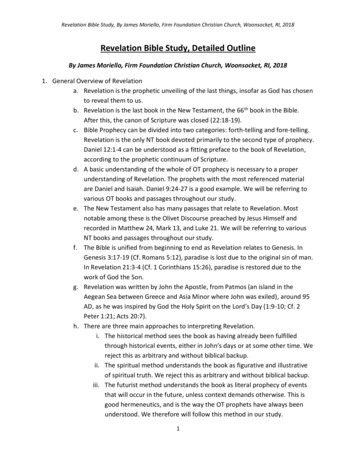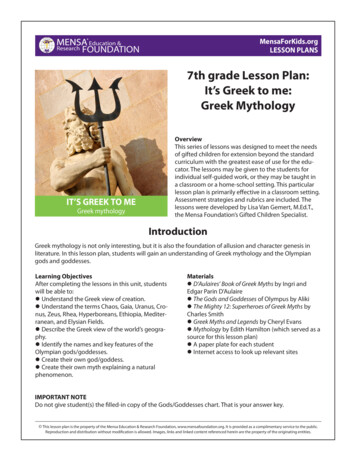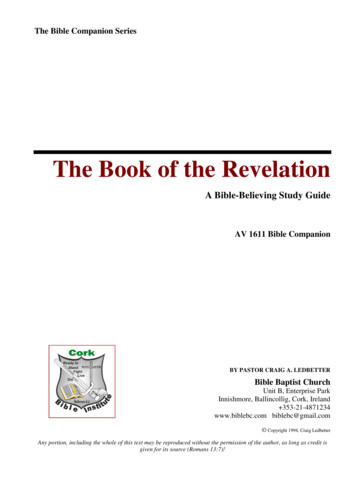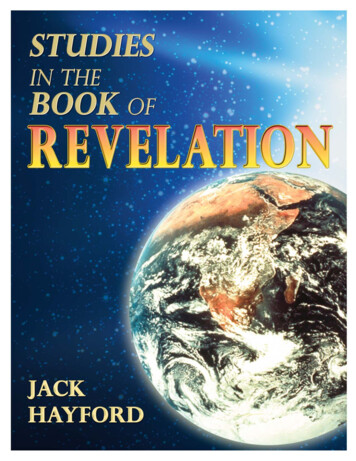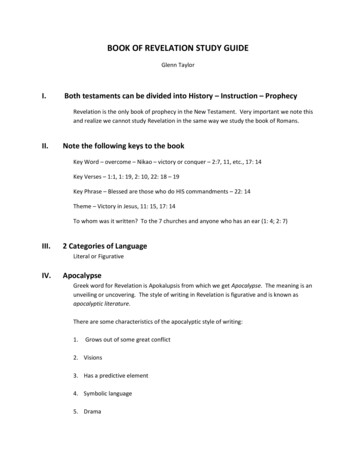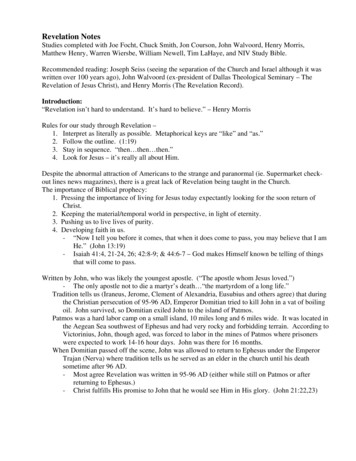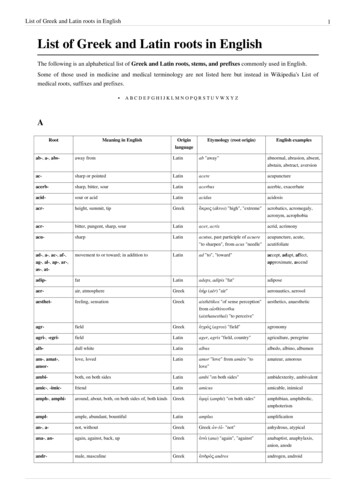
Transcription
-1-The RevelationofJohnpart ofThe Holy BibleThe Ancient Greek Text,alternating verse by verse withA new English translation from the Greek by David Robert Palmerwith translator's footnotes and Greek textual variant e.xipfs://ebibles.xipfs://ebibles.zilDecember 2020 Edition(First Edition was April 08, 2006)Printed Editions are soon available.You do not need anyone's permission to quote from, store, print, this document.Just do not change the text. If you quote it, you might put (DRP) after your quotation.
-2ForewordFootnote ApparatusI have tried to list all major Greek textual variants, and many of the minor ones. Variants thatare not translatable into English are usually marked within the Greek text, and those that canaffect the English rendering, marked in the English text. If this document is an edition withoutthe Greek text alternating verse by verse with the English, then that explains why you mightfind a footnote referenced to "19:3c" but there are no footnotes for 19:3b or a. Those other twofootnotes may be found in an edition that has the Greek text included.The footnotes about Greek textual variants are in the following format. Here is a fictionalfootnote for an example.19:15a txt σιδηρᾷ A 046 0226 205 209 2344 A itar vgww syrph copsa Cyprian Irenaeus TRNA27 {\} // δίστομος ℵ P 1006 1841 1854 2030 2329 Κ itgig vgcl syrh copbo arm ethAmbrose Primasius RP.The 19:15a means it is a footnote about chapter 19 v. 15, and the "a" implies that there is atleast one other footnote about the verse. The letters "txt" mean that the text of my Englishtranslation follows the first (next) Greek reading given. Next comes my rating of my certaintyfor this variant, as a capital letter in curly brackets. Not all variants have one, since I am stilldeveloping my opinions thereon.After that come the Greek word(s), σιδηρᾷ, upon which my translation is based.Next comes the listing of Greek manuscripts, first for the reading I translated, then any othervariants, separated by "//". (Regarding the Greek manuscripts, their description, date, andgenealogy, etc., see the table at the end of the document.) Uncials (mss. whose text is written inall capital letters) are listed first (those designated by a capital Hebrew, Latin or Greek letter, ora number starting with a zero), then minuscules (those designated by a number not starting witha zero), then what division of the Majority of minuscules follow that reading ( A or Κ), ifapplicable, ( means the majority of minuscules), then early versions into other languages; firstthe italic, then vulgate editions, then Syriac, then Coptic, then others less important such asArmenian and Ethiopic. (The "arab" referred to is that of Walton's Polyglot.) After that comeearly church fathers, if any.Lastly, I list which ones out of six Greek New Testament editions follow that reading. They arelisted in the following sequence as well. The letters TR stand for the 1550 Stephanus TextusReceptus; RP means the Robinson-Pierpont 2005 edition; NA27 means the Nestle-Aland 27thedition, and lastly, the curly brackets {B} contain the rating of certainty given in the UBS4, theUnited Bible Societies' 4th Edition. When there is a left slash in the brackets like this, {\}, thatmeans that the UBS4 has neither footnote nor rating on that variant.There are over 300 Greek handwritten manuscripts containing Revelation or a portion thereof.Not all of them are significant or important as pertaining to textual criticism, to grosslyunderstate the matter. H. C. Hoskier, in the introduction to his apparatus in Concerning the Textof the Apocalypse, Volume 2, on p. 7 states, "There are two streams of the text of theApocalypse, one Ecclesiastical and one extra-Ecclesiastical, which only join far back and highamongst the hills near the primal fount." Though I don't necessarily subscribe to thatnomenclature, I, after for a while listing the readings of all 300-plus manuscripts, realized thatdoing so was little more informative than listing only those from approximately the 12th centuryand earlier.Hoskier has well pointed out how the uncials of the Revelation text are all over the place, withmany omissions and additions. The wildest of them all in Revelation is Sinaiticus. The onlyuncial that is not “all over the place,” but which seems to represent a standardized majority text,is the uncial 046 (called B in his work). Hoskier on p. xxvii of Volume One of "Concerning theText of the Apocalypse," calls this the "B revision, which was made in the VIIth century." Onp. xxxvi he calls it the "B recension." He goes on to say, "roughly speaking, B and cursivegroups may be neglected if opposed by a consensus of the older uncials, Versions and Fathers.If on the other hand B is joined Aleph, A or C, the greater weight can only be overborne by
-3other subsidiary evidence, and if B have the support of Aleph A or C A together, we must grantthe group a full hearing." In the same paragraph, he declares that Erasmus and Stephen reliedon just a few MSS that were faulty in certain particulars. And that we should restore fromTischendorf, Tregelles and Wescott and Hort readings taken away from the TR solely on thebasis of one uncial like Aleph or A. With this all I agree.I have in August 2015 adopted the sigla conventions of the NA28 for the correctors of CodexSinaiticus, and updated my apparatus accordingly:ℵ*4th centuryℵ¹4th – 6th century (only one occurrence- in 21:4ℵ²7th centuryaℵ²7th centuryℵ²b7th centuryℵc12th centuryHoskier declared that the uncial 046 is a highly edited and smoothed-over text. Therefore, when046 departs from MOST other uncials, its reading is highly dubious. When 046 differs fromALL other uncials, its reading is surely false. This fact gives greater value to any minusculesthat do not always follow 046, and diminishes the value of those that do. Minuscules that departare 922 1006 1611 1678 1778 1828 1841 2020 2040 2050 2053 2062 2065 2080 2329 23442351, and many of these are also quite early for Apocalypse minuscules. Consequently, thesehave greater value than other minuscules Minuscules that slavishly follow 046 are 82, 627, 920,2138. When these minuscules are not in unity, you will find a difference usually between theHodges/Farstad majority text vv. the Robinson/Pierpont majority text. In many of theseinstances, the Robinson text has recently moved toward the correct reading, away fromHodges/Farstad. Where the conjunction of 82, 627, 920 opposes another edition, there you haveclearly different text streams. Where minuscules 82, 627, 920 line up against most of theuncials, their reading is highly doubtful. Where these three line up with 046 against all otheruncials, you have a false reading, a wrong reading in the Majority Text. For example, omitἡλίου in 22:5c. There are also places where these three line up against all uncials and all earlyverions, even against 046; there you have most definitely, absolutely, a wrong reading in theHodges/Farstad edition, in my opinion.It would seem that many might agree with F.H.A. Scrivener, who said on p. 277 of Vol. 2 of"Criticism of the New Testament," as follows: "If the question be fairly proposed, 'What righthave we to set virtually aside the agreement in the main of our oldest uncials, at the distance ofone or two centuries—of which, owing probably to the results of persecution, we have no MS.remains—with the citations of the primitive Fathers, and with the ancient versions?': the answermust be rendered, without hesitation, 'no right whatsoever.' Where the oldest of theseauthorities really agree, we accept their united testimony as practically conclusive. It is not atall our design to seek our readings from the later uncials, supported as they usually are by themass of cursive manuscripts; but to employ their confessedly secondary evidence in thosenumberless instances wherein their elder brethren are hopelessly at variance, eg. Matt. 1:18,Acts 8:37 for Irenaeus, Acts 13:33 for Origen. It is rare indeed that the express testimony of aFather is so fully confirmed by the oldest copies as in John 1:28, where Βηθανίᾳ, said by Origento be σχεδὸν ἐν πᾶσι τοῖς ἀντιγράφοις, actually appears in ℵ* A B C*."On the other side of the coin, I grant that where the UBS text favors the uncial A when it standsalone against all other witnesses, their reading is dubious, the most famous one beingRevelation 5:9. Hoskier points out that Hort broke one of his own rules with this one, as hewent with the easiest reading. But there are several places in Revelation where Codex A showsthat it is an older text, with older readings, prior to editing and standardization. So at this point,I still understand why the UBS/NA editors value Codex A extremely highly for Revelation. If Iwere only allowed to have one ancient Greek manuscript of Revelation, I would definitelychoose Codex A.I have come up with 20 test passages (contained at the end of this document and signaled by theabbreviation TST), by which to classify the main Apocalypse manuscripts. The manuscriptsmay be placed on a continuum as shown below, with Codex A being on one end, and 757 the
-4other, as the texts most differing from each other. And that continuum roughly corresponds tothe GNT editions which line up like this:NA27 TR RP HF PK.A C ⁴⁷ ¹⁸ 0207 2080 1678 1778 2062 ¹¹⁵ 2053 1611 2050 1841 ℵ* 1006 ⁴³ 2020 01632040 2329 2065 99 469 616 181 69 459 424 1862 1888 P 172 922 2814 1828 2060 2084 20742186 ¹ℵ 2351 61 2081 2302 792 1732 104 1854 2059 2019 2436 35* 256Gr 046 94 175 2412017 2042 051* 2256 18 1859 1384 1852 2073 1733 2030 367 920 82 456 627 2138 468 2070467 757 35c 051cHoskier in Volume 1 where he discusses 1678 says that the family of 052 1678 1778 2080 is avery old text type, and he estimates it to be about 50 years older than that of Codex Sinaiticus (ℵ ). He gives some examples of where ℵ conflates the reading of the 052 family with that ofanother line. I have come up with a shorthand for the agreement of this family, and that is thesigla ƒ052. Hoskier says that it has much weight, though not enough to be considered theoriginal by itself, but in combination with a couple other uncials. I agree with this, and that ismy general policy, to treat ƒ052 as a high quality uncial. If it agrees with one or more otheruncials (especially if other than ℵ ), you have to give that reading very serious weight. Wherethere is an agreement of ƒ052 A C along with say, another uncial like P or 046, that is the truetext, no matter if three hundred cursive manuscripts disagree.Consistently cited Greek witnesses (where text is extant) for Revelation are these thirty-one:¹⁸, ²⁴, ⁴³, ⁴⁷, ⁸⁵, ⁹⁸, ¹¹⁵, ℵ, A, C, P, 046, 051, 052, 0163, 0169, 0207, 0308, 922, 1006,1611, 1678, 1778, 1828, 1841, 2040, 2050, 2053, 2062, 2080, 2329. When 1678, 1778, 2080are united, the sigla ƒ052 is used, even when the uncial 052 has a hiatus, though if one of thethree cursives has a hiatus, they are listed separately. Where 052 is extant, the same applies: ifthey are split, or if one of the three cursives has a hiatus, they are listed separately; otherwise,the sigla is used. If there is a hiatus in any of the above, it will be noted, except if thatmanuscript is only a fragment anyway. Fragmentary mss. not therefore listed for hiatus, wouldbe: ¹⁸, ²⁴, ⁴³, ⁴⁷, ⁸⁵, ⁹⁸, ¹¹⁵, 052, 0163, 0169, 0207, 0308. But if I do cite one of thesefor hiatus, that means that it does contain text in that surrounding area of Revelation. Ifrequently or occasionally cite mss. out of an additional 55 minuscules: 18, 35, 61, 69, 82, 88,94, 104, 172, 175, 181, 241, 256, 367, 424, 456, 459, 467, 468, 469, 616, 627, 757, 792, 920,1384, 1732, 1733, 1852, 1854, 1859, 1862, 1888, 2017, 2019, 2020, 2030, 2042, 2060, 2065,2070, 2073, 2074, 2081, 2084, 2138, 2186, 2256, 2302, 2344, 2351, 2377, 2432, 2436, 2814 fora total of 85 hand-written Greek manuscripts. We really should not include anywhere, mss. 296and 2049, which were merely handwritten copies of printed editions. Hoskier stated this plainlyin several places of his work; see the table of MSS. at the end of this document.
-5-ΑΠΟΚΑΛΥΨΙΣ ΙΩΑΝΝΟΥThe Revelation of JohnChapter 1Prologue1:1 Ἀποκάλυψις Ἰησοῦ Χριστοῦ, ἣν ἔδωκεν αὐτῷ ὁ θεός, δεῖξαι τοῖς δούλοιςαὐτοῦ ἃ δεῖ γενέσθαι ἐν τάχει, καὶ ἐσήμανεν ἀποστείλας διὰ τοῦ ἀγγέλουαὐτοῦ τῷ δούλῳ αὐτοῦ Ἰωάννῃ,¹The Revelation of Jesus Christ, which God gave to him, to show to hisservants what things must soon take place, and which he signified when he sentit via his angel to his servant John,1:2 ὃς ἐμαρτύρησεν τὸν λόγον τοῦ θεοῦ καὶ τὴν μαρτυρίαν Ἰησοῦ Χριστοῦ, ὅσαεἶδεν.1²who has confirmed as the word of God and the testimony of Jesus Christ,what all things he saw.21:3 μακάριος ὁ ἀναγινώσκων καὶ οἱ ἀκούοντες τοὺς λόγους τῆς προφητείαςκαὶ τηροῦντες τὰ ἐν αὐτῇ γεγραμμένα, ὁ γὰρ καιρὸς ἐγγύς.³Blessed are the one reading and those listening to the words of this prophecy,and keeping the things written herein, for the time is near.1:4 Ἰωάννης ταῖς ἑπτὰ ἐκκλησίαις ταῖς ἐν τῇ Ἀσίᾳ· χάρις ὑμῖν καὶ εἰρήνη ἀπὸ ὁὢν καὶ ὁ ἦν καὶ ὁ ἐρχόμενος, καὶ ἀπὸ τῶν ἑπτὰ πνευμάτων ἃ ἐνώπιον τοῦθρόνου αὐτοῦ,⁴John, to the seven churches in Asia, grace to you, and peace, from Him3 whois, and who was, and who is to come, and from the seven spirits before histhrone,41:2a txt {A} ὅσα ℵ A C P 046 922 1006 1611 1678 1828 1841 2040 2050 2053 2062 2070 2080 2329RP NA28 {\} ‖ ὅσα τε TR ‖ lac21:2b txt {A} omit ℵ A C P 046 1006 1611 1828 1841 2040 2050 2053 2062 2070 2080 2329 vgith,ar,gig syrph,h copsa,bo eth K TR RPtxt NA28 {\} ‖ add: καὶ ἅτινα εἰσί(ν) καὶ ἅτινα χρήγενέσθαι μετά ταῦτα 2 6 ‖ add: καὶ ἅτινα εἰσί καὶ χρή γενέσθαι μετά ταῦτα 922 ‖ add: καὶ ἅτιναἐστι καὶ ἅτινα χρή γενέσθαι μετά ταῦτα 2 9 ‖ add: καὶ ἅτινα εἰσί καὶ διὰ τινα χρή γενέσθαιμετά ταῦτα 2‖ καὶ ἅτινα εἰσί καὶ ἅ χρή γενέσθαι μετά ταῦτα3 4 arm Andr Areth ‖ add:καὶ ὅτι δι' ἀγγέλου δέδοται 1678 ‖ καὶ ἅτινα εἰσιν καὶ ἅτινα χρή γενέσθαι μετὰ ταῦτα RPmg ‖ lac051 1778.vid31:4a txt ἀπὸ "from him" ¹⁸ ℵ A C P 922 1678 2050 2080 itgig,h vg syrph,h copsa,bo Apr PrimPs-Ambr NA28 {\} ‖ ἀπὸ θεοῦ "from God": 466 64 2 4 2 3 2329 it (ar),t Vict PrimRP ‖ ἀπὸ τοῦ (genitive article) TR ‖ lac 051 1778. The TR reading is based on about eight lateand insignificant mss. The minuscule 2062txt has ἀπὸ τοῦ, but followed by a completelydifferent phrase than the TR- πάντων ἡμῶν θεοῦ instead of ὁ ὢν καὶ ὁ ἦν καὶ ὁ ἐρχόμενοςDeBrunner in BDF §143 says about the unexpectedly nominative title of God here followingthe genitive ἀπὸ, that this was preserving the formula for the divine name that had arisenfrom rabbinical exegesis of Exodus 3:14 “ἐγώ εἰμι ὁ ὤν” - ֶ ְֽהיֶ ֶ֑ה ℵ ֲֶשֶׁ֣ר ℵ ֶ ְֽהיֶ ֶ֖ה .41:4b txt ἃ (nom or acc pl neut rel. pronoun) ¹⁸ C 046 1006 1611 1841 2040 2050 2329 RPtxtNA28 {\} ‖ τῶν (gen pl) ℵ A ‖ ἃ ἐστιν (nom or acc pl neut rel pronoun with singular verb) P1678 2053 2062 2080 TR RPmg ‖ ἃ εἰσιν (nom or acc pl neut pronoun with plural verb) 2 9itgig,h ‖ lac 051 1778. DeBrunner in BDF §136(1) says that the Greek of Revelation exhibitsmany solecisms (mainly inattention to grammatical agreement), which were later removed byeducated revisers, and he says of the phrase in :4, ἀπὸ τῶν ἑπτὰ πνευμάτων ἃ ἐνώπιον τοῦθρόνου αὐτοῦ that "the true text is still not found in any edition; originally it certainly read:1
-61:5 καὶ ἀπὸ Ἰησοῦ Χριστοῦ, ὁ μάρτυς ὁ πιστός, ὁ πρωτότοκος τῶν νεκρῶν καὶ ὁἄρχων τῶν βασιλέων τῆς γῆς. Τῷ ἀγαπῶντι5 ἡμᾶς καὶ λύσαντι ἡμᾶς ἐκ τῶνἁμαρτιῶν ἡμῶν ἐν τῷ αἵματι αὐτοῦ –⁵and from Jesus Christ, the faithful witness,6 the firstborn from the dead, andruler over the kings of the earth. To him who loves us, and freed 7 us from8 oursins with9 his blood,1:6 καὶ ἐποίησεν ἡμᾶς10 βασιλείαν, ἱερεῖς τῷ θεῷ καὶ πατρὶ αὐτοῦ – αὐτῷ ἡδόξα καὶ τὸ κράτος εἰς τοὺς αἰῶνας [τῶν αἰώνων]11 ἀμήν.⁶and made us into a kingdom of priests12 for his God and Father– to him beglory and power, for ever and ever. Amen.ἀπὸ τῶν ἑπτὰ πνευμάτων τὰ ἐνώπιον τοῦ θρόνου αὐτοῦ This jarred upon every cultured ear,hence the five variants." That is, in place of “τα” (acc neut pl), the above variants arose.(DeBrunner was saying that the accusative case pronoun “τὰ” jarred the cultured ear for itslack of concord with the genitive case of πνευμάτων.) My translation reflects most of theother readings, which have essentially the same meaning after translation into English. If onefollowed the Andreas of Caesarea “ἃ ἐστιν” reading, the one with the singular verb, that mightbest be translated "the seven-fold Spirit of God."51:5a txt τ ἀγαπῶντι ¹⁸ ℵ A C 046 1006 1611 1678(rescr) 1841 2040 2080 RPtxt NA28 {\} ‖ τἀγαπήσαντι P 2 3 2 62 TR RPmg ‖ τ ἀγαποντι 2050 2329 ‖ lac 051 1778.61:5b Or, "the faithful martyr." The Greek word translated witness here is martyr, and thereis good reason it came to have the connotation of one who is killed for his witness. For that iswhat happened to Jesus Christ, and also to Antipas, mentioned later in this book in 2:13,where he is also called a faithful witness/martyr.71:5c txt {A} λύσαντι ¹⁸ ℵ A C 1611 1678 2050 2329 2344vid (ith Prim soluit) vg-harl (syrphλύων) (ἔλυσεν syrh arab) eth arm Andrew; Vict-Pett NA27 {A} ‖ λούσαντι P 46c (046*homoioteleuton)6 4 (ἔλουσεν itgig vg copsa,bo) 2040 2053 2062 2080 itar,t vg copbo AprAreth Beat TR RP ‖ lac 051 1778. The "freed" reading is reminiscent of λέλυται αὐτῆς ἡἁμαρτία in Isaiah 40:2, and it fits better with the preposition ἐν, see other footnote on thisverse.1:5d txt {A} ἐκ ¹⁸ ℵ*,² A C 1611 1678 2050 2053 2062 2080 2329 2344vid NA27 {A} ‖ ἀπό P 461006 1841 2040 TR RP ‖ lac 051 1778.91:5e This is a Hebraistic use of the preposition “ἐν” meaning "with" in the sense of what itemor money you use to pay for something. For example, "I bought the camera with the moneyyou gave me." Jesus' blood was the thing of value exchanged for our freedom. This use of thispreposition is a pointer in favor of the "freed" reading versus the "washed" reading,according to the Textual Commentary on the Greek New Testament. That scribes, notunderstanding this, thought that "washed in" made more sense than "freed in."101:6a txt ἡμᾶς ℵ P 046 922 1006 1828 1841 2040 2050 itar,gig vgcl Tert Vic Prim TR RP NA28{\} ‖ ἡμῖν ¹⁸ A 1678 2053 2062 2080 2344 ‖ ἡμῶν C 1611 2329 ith,t vg ‖ lac 051 1778.111:6b txt {C} αἰῶνας τῶν αἰώνων ℵ² (τα αιωνα ℵ*) C 046 922 1006 1611 1678 1841 2040 20532062 2080 2329itar,h vg syrph,h (arm) eth Did TR TG RP SBL ([αἰῶνας τῶν] NA2 ) {C} ‖αἰῶνας ¹⁸ A P 2050 copbo ‖ lac 051 1778.121:6c txt βασιλείαν ἱερεῖς ¹⁸ ℵ* A C 922 1006 1611 1678 1828 1841 2040 2053 2062 2080 23298RP NA28 {/} ‖ βασιλειαν ιεραν syrph,h ‖Ⲃ copbo ‖ βασιλειαν και ℵcitgig Ps-Ambr ‖ βασιλειον και 46 2‖ βασιλεῖς καὶ ἱερεῖς P TR ‖ lac 051 1778 copsa. SeeMussies, G., "The Morphology of Koine Greek, as used in the Apocalypse of St. John: A Study inBilingualism," Leiden, Brill Academic Pub. Novum Testamentum, Suppl. 27 (1971), "This line,as Charles has pointed out, is a quotation from Symmachus' and Theodotion's rather literalversions of Exodus 19:6, 'a kingdom of priests'. The LXX-version has βασίλειον ἱεράτευμα [andfound in a dozen minuscules here] (quoted in Peter 2:9), and Aquila translated by βασιλείανἱερέων Editors should threfore not place a comma after βασιλείαν, as ἱερεῖς is not anapposition, but represents a more grammatical ἱερέων " (genitive plural)
-71:7 Ἰδοὺ ἔρχεται μετὰ τῶν νεφελῶν, καὶ ὄψεται αὐτὸν πᾶς ὀφθαλμὸς καὶοἵτινες αὐτὸν ἐξεκέντησαν, καὶ κόψονται ἐπ’ αὐτὸν πᾶσαι αἱ φυλαὶ τῆς γῆς.ναί, ἀμήν.⁷Behold, he is coming with the clouds, and every eye shall see him, includingof those who pierced him. And all the peoples of the earth shall beat theirbreasts over him.13 Let it be so, amen.1:8 Ἐγώ εἰμι τὸ Ἄλφα καὶ τὸ Ὦ, λέγει κύριος ὁ θεός, ὁ ὢν καὶ ὁ ἦν καὶ ὁἐρχόμενος, ὁ παντοκράτωρ.⁸"I am the Alpha and the Omega,"14 says the Lord God,15 "the one who is, andwho was, and who is to come, the Almighty."Someone Like a Son of Man1:9 Ἐγὼ Ἰωάννης, ὁ ἀδελφὸς ὑμῶν καὶ συγκοινωνὸς16 ἐν τῇ θλίψει καὶβασιλείᾳ καὶ ὑπομονῇ ἐν Ἰησοῦ,17 ἐγενόμην ἐν τῇ νήσῳ τῇ καλουμένῃ Πάτμῳδιὰ τὸν λόγον τοῦ θεοῦ καὶ τὴν μαρτυρίαν Ἰησοῦ.⁹I, John, your brother and fellow in the oppression and kingdom andendurance in Jesus, was on the island called Patmos because of the word of Godand the testimony of Jesus.18 191:10 ἐγενόμην ἐν πνεύματι ἐν τῇ κυριακῇ ἡμέρᾳ, καὶ ἤκουσα ὀπίσω μου φωνὴνμεγάλην ὡς σάλπιγγος¹⁰I was in the Spirit during the Lord's day, and I heard behind me a loud voice,like of a trumpet,1:11 λεγούσης, Ὃ βλέπεις γράψον εἰς βιβλίον καὶ πέμψον ταῖς ἑπτὰἐκκλησίαις, εἰς Ἔφεσον καὶ εἰς Σμύρναν καὶ εἰς Πέργαμον καὶ εἰς Θυάτιρα καὶεἰς Σάρδεις καὶ εἰς Φιλαδέλφειαν καὶ εἰς Λαοδίκειαν.¹¹saying,20 "What you see, write in a book, and send it to the seven churches–to Ephesus, and to Smyrna, and to Pergamum, and to Thyatira, and to Sardis,and to Philadelphia, and to Laodicea."131:7 Daniel 7:13 ּו ְׁקדָ מֹוהִי ַהק ְְׁׁרבּוהִי , עַתִ יק יֹו ַמי ָא מְׁ טָה - ְׁכבַר ֱאנָש ָאתֵ ה ֲהוָא; ְׁועַד , שמַ י ָא ְׁ ֲענָנֵי - ַואֲרּו עִם iah 12:10- 4 The LXX wording in 2: 2 is καὶ κόψεται ἡ γῆ κατὰ φυλὰς φυλάς "Andthe land [of Israel] will mourn tribe by tribe." Hebrew: ּונְׁשֵיהֶם ְׁלבָד , נָתָ ן ְׁלבָד - ש ַפחַת בֵית ְׁ ִמ -- ּונְׁשֵיהֶם ְׁלבָד , דָ וִיד ְׁלבָד - ש ַפחַת בֵית ְׁ ִמ : שפָחֹות ְׁלבָד ְׁ שפָחֹות ִמ ְׁ ִמ , ָָארץ ֶ ְׁו ָספְׁדָ ה ה .http://www.mechon-mamre.org/c/ct/c2312.htm141:8 txt {A} omit ℵ²a A C P 046 922 1006 1611 1678 1841 2040 2053 2062 2080 ith syrph,h arm ethEpiphan; Ambr Varim Prim RP NA27 {A} ‖ add ἀρχὴ καὶ τέλος ℵ*,²b 1828 2050 2344 itar,gig,t vgA copbo Andrew; Apr Beat TR ‖ add ἡ ἀρχὴ καὶ τὸ τέλος 2329 ‖ lac 051 1778 2030 copsa. Thelonger phrase is present in 21:6 in all editions, some with and some without the articles.151:8b txt κύριος ὁ θεός ℵ A C P 046 922 1006 1611 1678 1828 1841 2040 2053 2062 2080 ithsyrph,h copbo Prim RP NA28 {/} ‖ ὁ κύριος ὁ θεός arab Apr ‖ ὁ θεός 2329 eth ‖ ὁ κύριος 2050 TR ‖lac 051 1778161:9a txt συγκοινωνὸς A 46 ƒ 2 1611 1828 2050 2053 2062 TR NA28 {\} ‖ συνκοινωνὸς ℵ C P2329 ‖ κοινωνὸς 922 1006 1841 2040 RP ‖ lac 051.171:9b txt {A} Ἰησοῦ ℵ* C P ƒ 2 6 2050 NA28 {\} ‖ Χριστ A ‖ Ἰησοῦ Χριστ ℵ² ‖ ἸησοῦΧριστοῦ 2329 TR ‖ Χριστ Ἰησοῦ 046 922 1006 1828 1841 2040 RP ‖ omit 2053 2062 ‖ lac 051.181:9c Or, “because of the witness about Jesus ”191:9d txt {A} Ἰησοῦ ℵ* A C P ƒ 2 6 22329 NA28 {\} ‖ Ἰησοῦ χριστοῦ ℵ² 046 922 18281841 2040 TR RP ‖ omit 2053 2062 ‖ lac 051. Mss. 2053 and 2062 have a mixture of text andcommentary here that is very different from the rest of the witnesses.201:11 txt λεγούσης ℵ* A C 046 1006 1828 1841 2329 RP NA28 {\} ‖ λεγουσαν ℵ² ‖ φωνούσης ƒ 2 ‖λαλούσης 2 4 ‖ omit 2050 ‖ λεγούσης μοι 6 ‖ λεγούσης μοι Ἰωάννη 2 3 2 62 ‖ λεγούσης,
-81:12 Καὶ21 ἐπέστρεψα βλέπειν τὴν φωνὴν ἥτις ἐλάλει22 μετ’ ἐμοῦ· καὶἐπιστρέψας εἶδον ἑπτὰ λυχνίας χρυσᾶς,¹²And I turned around to see the voice that was speaking with me. And whenI turned, I saw seven golden lampstands,1:13 καὶ ἐν μέσῳ τῶν λυχνιῶν ὅμοιον υἱὸν23 ἀνθρώπου, ἐνδεδυμένον ποδήρηκαὶ περιεζωσμένον πρὸς τοῖς μαστοῖς ζώνην χρυσᾶν·24¹³and in among25 the lampstands26 was someone like a son of man,27 dressed ina cloak reaching down to his feet, and gird around at28 the pecs29 with a goldensash,1:14 ἡ δὲ κεφαλὴ αὐτοῦ καὶ αἱ τρίχες λευκαὶ ὡς ἔριον30 λευκόν, ὡς χιών, καὶοἱ ὀφθαλμοὶ αὐτοῦ ὡς φλὸξ πυρός,¹⁴except his head and his hairs were white like wool, as white as snow, and hiseyes like flames of fire,1:15 καὶ οἱ πόδες αὐτοῦ ὅμοιοι χαλκολιβάνῳ ὡς ἐν καμίνῳ πεπυρωμένης, καὶἡ φωνὴ αὐτοῦ ὡς φωνὴ ὑδάτων πολλῶν,¹⁵and his feet like bronze as if made to glow31 in a furnace,32 and his voice likethe sound of many waters,Ἐγὼ ἄλφα καὶ τὸ Ω, πρῶτος καὶ ὁ ἔσχατος· καὶ, P ‖ λεγούσης, Ἐγὼ Α καὶ Ω, πρῶτος καὶ ὁἔσχατος·922 ‖ λεγούσης, Ἐγὼ εἰμι τὸ Α καὶ τὸ Ω, ὁ πρῶτος καὶ ὁ ἔσχατος· καὶ, TR ‖ lac 051.211:12a txt omit TR RPZ ‖ ἐκεῖ RPT221:12b txt ἐλάλει ℵ C 046 ƒ 2 1006 1828 1841 2053 2062 2329 RP NA28 {\} ‖ λαλει A ‖ ἐλαλη2040 ‖ ἐλάλησε(ν) P 922 6 syrph TR ‖ τον λαλουντα μοι (in place of τὴν φωνὴν ἥτις ἐλάλειμετ’ ἐμοῦ) 2‖ lac 051 2030.231:13a txt υἱὸν RPZ ‖ ὑι RPT241:13b txt χρυσᾶν ℵ* A C (Cypr Iren) NA28 {\} ‖ χρυσην ⁹⁸ ℵ² ‖ χρυσήν34 23 ‖χρυσὴν 1894 2254 2256 ‖ χρυσῆν rell. Gr. TR RP ‖ χρυσιν 46 9 2 4 2 4? ‖ χρυσ (sic) 1719 ‖χρουσουν 9 3 Aldus ‖ lac 051 314 1352 1774 1893 1918 2022 2030 2075 2091.251:13c If this were talking about the menora of Exodus chapter 25, then Tyndale's rendering,"in the midst of the candlesticks" would be most accurate, since with the menora there wasonly one lampstand, with 6 branches going out sideways, and one in the middle. But if thereare 7 free standing, separate, lampstands, a rendering like "in among the lampstands" isbetter. In our context here, the 7 lampstands refer to the seven churches of Asia Minor, Rev1:20. Jesus "walks among the seven golden lampstands," Rev. 2:1. These lampstands are injeopardy of being removed. Rev 2:5 says Jesus "will remove your lampstand from its place,unless you repent." Therefore I conclude that these lampstands are not the menora ofExodus.261:13d txt {A} λυχνιῶν A C P ƒ 2 1611 2050 ith syrph,h copsa,bo Irenlat Cypr Vict Prisc TR Erasmus 1,2,3 Aldus Colinaeus NA28 {\} ‖ ἑπτὰ λυχνιῶν ℵ 046 922 1006 1828 1841 2040 20532062 2329 itgig vg TR-Steph TR-Scriv RP ‖ lac 051.271:13e It is customary to render this phrase as “like a Son of Man,” so that it reminds thereader of this phrase in the prophets Ezekiel and Daniel, etc. But it would be more accurate totranslate it "like a human," because that is what seems to be the emphasis here in contrast tolater given non-human traits. John first gives traits of him that are human, and then hebegins verse 14 with "but," and proceeds in the next several verses to tell us traits that are nothuman.281:13f txt πρὸς rell Gr TR RP NA28 {\} ‖ ἐν 2 2 424 2 6 66222 2 2 322053 2055* 2062 2084 copbo ‖ ad itgig vg Iren Vict Apr Ps-Ambr ‖ super ith ‖ supra Cass PrimCypr Jul ‖ inter Tyc 2 ‖ omit 2060 2286 2302 ‖ lac 051 314 1352 1774 1893 1918 2022 2030 20752091.291:13g Literally, "breasts," μαστοῖς but that would be very unidiomatic for English, and itessentially means chest, as in 15:6, where the seven angels also have a golden sash aroundtheir chest, and there the Greek word used is στῆθος, "chest." But I didn't want to translateμαστοῖς as a singular word like chest, when the Greek is plural, so I used "pecs" which is shortfor pectorals.301:14 txt ὡς ἔριον RPT ‖ ὡσεὶ ἔριον RPZ
-91:16 καὶ ἔχων ἐν τῇ δεξιᾷ χειρὶ αὐτοῦ,33 ἀστέρας ἑπτά, καὶ ἐκ τοῦ στόματοςαὐτοῦ ῥομφαία δίστομος ὀξεῖα ἐκπορευομένη, καὶ ἡ ὄψις αὐτοῦ ὡς ὁ ἥλιοςφαίνει ἐν τῇ δυνάμει αὐτοῦ.¹⁶and he was holding in his right hand seven stars, and out of his mouth wascoming a sharp two-edged sword, and his face was like the sun shining in thestrength of it.1:17 Καὶ ὅτε εἶδον αὐτόν, ἔπεσα πρὸς τοὺς πόδας αὐτοῦ ὡς νεκρός· καὶ ἔθηκεντὴν δεξιὰν αὐτοῦ ἐπ’ ἐμὲ λέγων, Μὴ φοβοῦ· ἐγώ εἰμι ὁ πρῶτος καὶ ὁ ἔσχατος,¹⁷And when I saw him, I fell down by his feet as though dead. And he placedhis right hand on me, saying, "Do not fear. I am the First and the Last,1:18 καὶ ὁ ζῶν, καὶ ἐγενόμην νεκρὸς καὶ ἰδοὺ ζῶν εἰμι εἰς τοὺς αἰῶνας τῶναἰώνων, καὶ ἔχω τὰς κλεῖς τοῦ θανάτου καὶ τοῦ ᾅδου.¹⁸and the Living One, and I was dead, and behold, living for ever and ever, 34and I have the keys of death and of Hades.351:19 γράψον οὖν ἃ εἶδες καὶ ἃ εἰσὶν καὶ ἃ μέλλει γίνεσθαι36 μετὰ ταῦτα.¹⁹"Write therefore what things you see and what things are now, and also whatthings are about to take place after these things.1:15a txt πεπυρωμένης (gen sing fem) A C Prim NA2 {C} ‖ πεπυρωμένῳ (dat sing) ℵ 20502053 2062 itar,gig,h,t vg syrph,h copsa,bo arm eth Iren Cypr Vict-Pett Matern Apr Prim Ps-AmbrHaymo Beat ‖ πεπυρομένοι 922 2329 ‖ περπυρωμένοι 46* ‖ πεπυρωμένοι (nom pl masc) P ƒ 21006 1611 1828 1841 2040 syrhmg Andrew; Arethas Vict-Pett Tyc TR RP ‖ lac 051 2030. Thefirst reading is feminine, and thus oblique grammatically to any of the nouns, whereas thesecond reading would modify furnace, and the third reading would modify feet. One canimagine why the first reading might be changed to one of the other two in order to be madegrammatically correct, but not why the 2nd or 3rd reading might be changed to thegrammatically oblique reading. And there are no other apparent explanations. The Greek ofthe rest of Revelation does in fact show more grammatical disagreement compared to otherN.T. books. Left oblique, the participle could be meant to modify bronze or furnace or feet, orall of them simultaneously. Why not? Revelation has several other places where the use ofὡς similarly makes a whole phrase rather imprecise321:15b The Greek verb here for "made to glow" is πυρόω - puróō, the word for burn, but usedsometimes in the New Testament for the purification of metals, as compared to the fire oftrials purifying faith. But that purification meaning of the word is impossible here, since themetal, χαλκολίβανον - chalkolíbanon, is an alloy, and alloys are by definition impure.According to Bauer, the alloy is of uncertain makeup, since this word is not found outside ofthe Apocalypse of John. It seems to contain the root words for copper and Libanon, the nameof a mountain range in Syria along the coast of the Mediterranean Sea. Thus the mostcommon translations of this word are alloys containing copper, such as bronze (copper andtin) or brass (copper & zinc).331:16 txt δεξιᾷ χειρὶ αὐτοῦ ℵ A C P ƒ 2 6 NA28 {\} ‖ δεξιᾷ Apringius ‖ χειρὶ αὐτοῦ 2070 ‖δεξιᾷ αὐτοῦ 2040 2050 2053 2062 latt arm² Prim ‖ χειρὶ αὐτοῦ τῇ δεξιᾷ 046 2329 ‖ δεξιᾷ αὐτοῦχειρὶ 922 1006 1828 1841 TR RP ‖ αὐτοῦ ⁹⁸ ‖ omit arm⁴ ‖ lac 051. CompareRev. 2:1.341:18a txt αἰώνων ⁹⁸ ℵ* A C P 922 1611 1678 2050 2053 2062 2080 NA28 {\} ‖ αἰώνων, ἀμήνℵ² 046 1006 1828 1841 2040 1778 2329 TR RP ‖ lac 051.351:18b txt κλεῖς τοῦ θανάτου καὶ τοῦ
the Greek text alternating verse by verse with the English, then that explains why you might find a footnote referenced to "19:3c" but there are no footnotes for 19:3b or a. Those other two footnotes may be found in an edition that has the Greek text included. The footnotes about Gre
